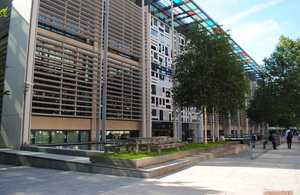True scale of modern slavery in UK revealed as strategy to tackle it published
New research estimates there are between 10 and 13 thousand potential victims of slavery in the UK.

Home Office
The figure is the first scientific estimate of the full scale of modern slavery and is contained in a wide-ranging strategy published by the Home Office on Saturday 29 November.
The Modern Slavery Strategy sets out co-ordinated action across government departments, agencies and law enforcement in the UK and internationally to tackle slavery, in addition to the legislative measures being introduced through the Modern Slavery Bill.
The strategy builds on the frameworks used to counter terrorism and fight organised crime. It sets out how we will:
- pursue the organised criminals and opportunistic individuals behind the modern-day slave trade;
- prevent people from engaging in modern slavery crime;
- protect vulnerable people by raising awareness and protecting them from becoming victims in the first place; and
- prepare better for when these crimes do take place, to reduce the harm they cause, through improved identification and enhanced support and protection for victims
Home Secretary Theresa May said:
The first step to eradicating the scourge of modern slavery is acknowledging and confronting its existence. The estimated scale of the problem in modern Britain is shocking and these new figures starkly reinforce the case for urgent action.
That is why I have introduced a Modern Slavery Bill, the first of its kind in Europe. But I have always been clear that legislation is only part of the answer.
The law must be rigorously enforced and we need wide-ranging activity. This strategy sets out the government’s approach which puts victims at the heart of everything we do.
Everyone must play their part if we are to consign slavery to history where it belongs.
The strategy also underlines the government’s commitment to not only tackle modern slavery in this country but around the world. It sets out ongoing work to tackle international modern slavery crime at source by working with law enforcement, civil society organisations and governments overseas. This will include an annual identification of priority countries, which will include both those from which significant numbers of victims are trafficked to the UK, as well as additional countries that suffer disproportionately from a high incidence of modern slavery, and individually tailored plans for each. While many victims identified in this country are foreign nationals, the strategy takes into account that vulnerable British adults and children are also being systematically preyed upon by traffickers and slave drivers. The National Crime Agency estimated that the UK was the third most common country of origin for victims identified in 2013.
The groundbreaking scientific research, led by the Home Office’s Chief Scientific Adviser Professor Bernard Silverman, was conducted to establish a better understanding of the scale of crime and gather an improved intelligence picture in order to influence the action needed to tackle it. It includes a ‘dark figure’ of victims who have not come to the attention of authorities.
Professor Silverman said:
Modern slavery is very often deeply hidden and so it is a great challenge to assess its scale. The data collected is inevitably incomplete and, in addition, has to be very carefully handled because of its sensitivity.
I very much hope that we will be able to build on these results and this approach to help tackle this issue, not just in this country but worldwide.
Welcoming the work, Professor Kevin Bales, co-founder of the Global Slavery Index, said:
This is superlative work. It is the first serious scientific effort to take the Multiple Systems Estimation methodology into the field of modern slavery and human trafficking.
This is very important because, while we are able in the Global Slavery Index to use random sample surveys to generate the equivalent of crime surveys for countries in the developing world, such surveys, for a number of reasons, will not provide estimates for the developed countries that have low levels of corruption, strong law enforcement and low levels of well-hidden victims.